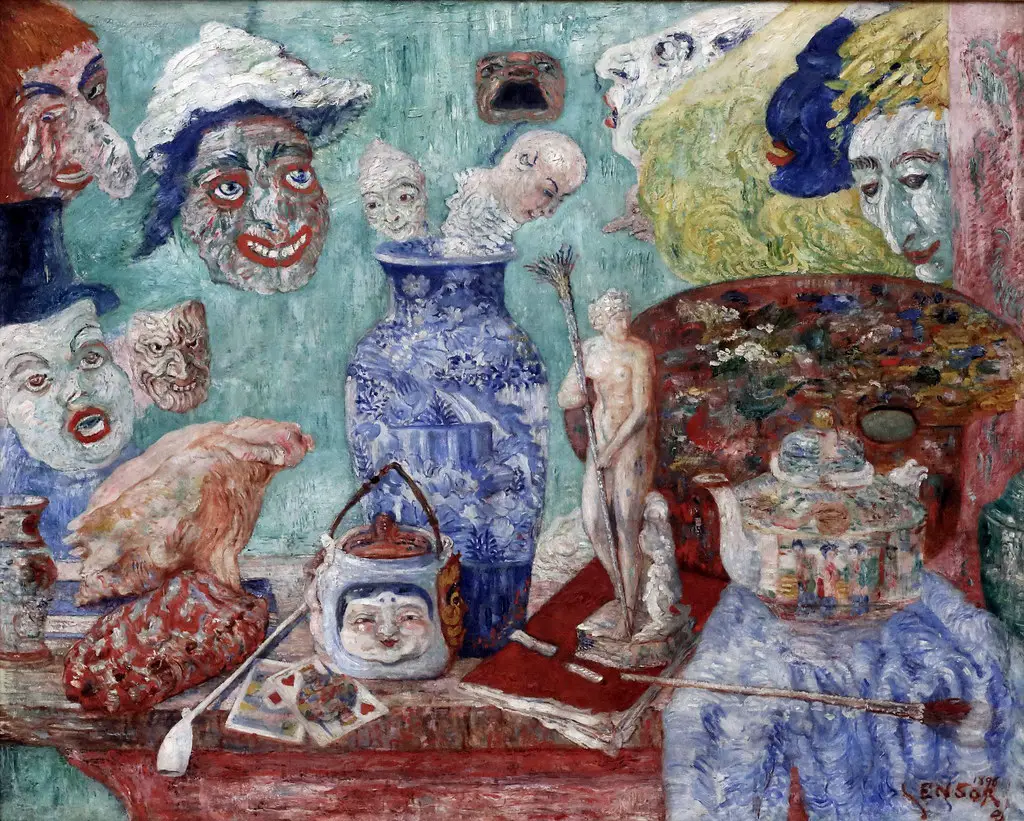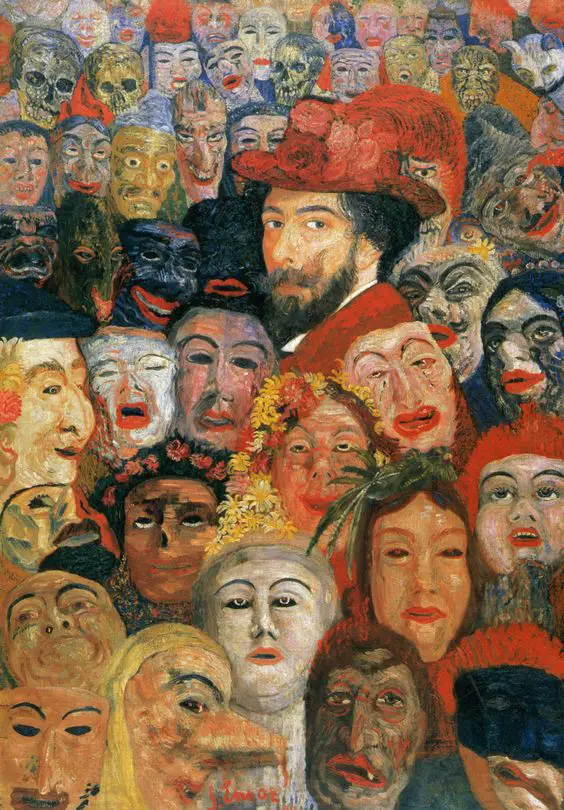It can be said that the theater is a symbol of the manifestation, of which it expresses in the most perfect way possible the illusory character; and this symbolism can be considered either from the point of view of the actor, or from that of the theater itself. The actor is a symbol of the "Self", or rather of the personality, which manifests itself through an indefinite series of states and modalities, which can be regarded as so many different parts; and it should be noted the importance that the ancient use of the mask had for the perfect accuracy of this symbolism.
di René Guénon
taken from Considerations on initiation, Luni Editore
cover: James Ensor, “Strange Masks”, 1892
We have equated the confusion of a being with its external and profane manifestation, to what one would commit if one wanted to identify an actor with a character in which he plays the part; some general considerations on the symbolism of the theater will not be out of place here, even if they apply to the realities of the properly initiatory sphere not exclusively as regards the theater alone. Indeed, it is obvious that a similar symbolism can be attributed to original character of the arts and crafts, all of which possessed such a value due to the fact that they were linked to a higher principle from which they proceeded as contingent applications, and they have become profane - as we have explained very frequently - only as a consequence of the spiritual decay of humanity along the course of the downward march of its historical cycle.
It can be said, in general, that the , be a symbol of the event, of which it expresses in the most perfect way possible the illusory character [1]; and this symbolism can be considered either from the point of view of the actor, or from that of the theater itself. The actor is a symbol of the "Self", or rather of the personality, which manifests itself through an indefinite series of states and modalities, which can be regarded as as many different parts; and it is worth noting the importance of the ancient use of mask for the perfect accuracy of this symbolism [2].
In fact, under the mask the actor remains himself in the course of all his parts, just as the personality is "untouched" by all its manifestations; the abolition of the mask, on the contrary, forces the actor to modify his own physiognomy and thus seems to alter in some way his essential identity. In any case, however, the actor is basically something different from what he seems to be, just as the personality is something different from the manifold states manifested, which are nothing but the external and changing appearances with which it dresses itself in order to realize, according to the different ways that adapt to its nature, the indefinite possibilities that it contains in itself in the permanent actuality of non-manifestation.

Turning to the other point of view, we can say that the theater is an image of the world: both are properly a "representation", since the world itself, which exists only as a consequence and expression of the Principle, on which it essentially depends for all that it is, can be understood as a symbol, at its level, of the principial order, and this symbolic character it also confers a value higher than that which it does not have in itself, because it is in a similar way that it participates in a higher degree of reality [3].
In Arabic the theater is indicated with the word tamthil, which, like all those deriving from the common root "mathl", has the proper meaning of resemblance, comparison, image or depiction; and some Muslim theologians use the expression alam tamthil, which could be translated with "figurative world" or with "world of representation", to indicate everything that, in the sacred Scriptures, is described in symbolic terms and must not be understood in the literal sense.
It is especially noteworthy that some of them apply this expression in particular to what has some connection with the angels and with demons, which effectively "represent" the higher and lower states of being, and in fact they cannot obviously be described except in a symbolic way with terms taken from the sensible world; and - at least by a curious coincidence - on the other hand, the notable role that angels and demons had in the religious theater of the Western Middle Ages.

In fact, theater does not necessarily have to limit itself to representing the human world, that is to say, a single state of manifestation; it can also represent the upper and lower worlds. In the Medieval "mysteries" the scene was, for this reason, divided into different levels, which corresponded to the different worlds, generally divided according to a ternary division: heaven, earth, hell; and the action taking place simultaneously in these different divisions appropriately represented the essential simultaneity of the states of being. The moderns, who no longer understand anything of such a symbolism, have come to consider a "naivety" - not to say a foolishness - what instead had the deepest meaning here; and the rapidity with which this misunderstanding was produced, which is so remarkable in the writers of the seventeenth century, is astonishing; similar radical break between the mentality of the Middle Ages and that of modern times it is certainly not one of the minor riddles in history.
And since we talked about the "Mysteries", we believe it is not useless to point out the peculiarity of this denomination with its double meaning: [in French their spelling is mysteries] while strictly etymological terms should be written mysteries, since the word comes from the Latin Ministry, what does it mean "Office" or "function", which clearly indicates to what extent theatrical performances of this type were originally considered to be an integral part of the celebration of religious holidays [4]. But what is strange is that this name has contracted and shortened to become exactly a namesake of mysteries, and to be eventually confused with this other word, of Greek origin and completely different derivation; Could it be only by allusion to the "mysteries" of religion, staged in the representations of this name, that this assimilation could take place?
This may be a fairly plausible reason; but according to another perspective, if we consider that analogous symbolic representations took place in the "mysteries" of antiquity, in Greece and probably also in Egypt [5], one may be tempted to see something much earlier in this fact, and almost a symptom of continuity of a certain esoteric and initiatory tradition which manifests itself externally - at intervals more or less distant from each other - with similar shapes and characteristics, and with the adaptation required by the diversity of circumstances of time and place [6].

Moreover, we have often enough to point out, on other occasions, the importance - as a procedure of symbolic language - of phonetic assimilations between philologically distinct words; it is something that in truth does not present any characteristic of arbitrariness, whatever most of our contemporaries may think, and it is quite directly related to the modes of interpretation that refer to the nirukta Hindu; except that the secrets of the intimate constitution of language are today so lost that it is hardly possible to make allusion to them without everyone thinking that they are "false etymologies", or even banal "puns", and the same Plato, who has sometimes resorted to this kind of interpretations - as we have incidentally pointed out with regard to "myths" - finds no grace in the face of the pseudo-scientific "critique" of minds limited by modern prejudices.
To end these few observations, we will point out again, in the symbolism of the theater, another visual angle, the one that refers to thedramatic authorI different characters, such as many mental productions of the latter, they can be considered to represent its secondary modifications and in a certain way its extensions, more or less as happens for the subtle forms produced in the dream state [7]. The same observation would, moreover, apply to the production of any work of the imagination, of whatever kind it may be; except that, in the specific case of the theater, this is special, that this production is realized in a sensitive way, giving the real image of life, as it happens in dreams.
The author has therefore, in this regard, one truly "demiurgic" function, since it produces a world that draws everything from itself; and in this he is the true symbol of the Being that produces the universal manifestation. In this case, as in that of the dream, the essential unity of the producer of "illusory forms" is not influenced by a similar multiplicity of accidental modifications, in the same way as the Being who produces the manifestation, the unity of which, not even it , is influenced by the multiplicity of the manifestation. Therefore, from whatever point of view one may ask oneself, one always finds in the theater that character which is his profound reason - however ignored it is by those who have reduced it to something purely profane - a character which is that of constituting - by its very nature - one of the most perfect symbols of universal manifestation.

Note:
[1] Let's not say unreal; it goes without saying that the illusion is to be considered only a minor reality.
[2] Moreover, it is worth pointing out that this mask was called "person" in Latin; personality is - literally - what is hidden under the guise of individuality.
[3] It is always the vision of the world, either as referred to the Principle, or only intended for what it is in itself, which constitutes the fundamental difference between the point of view of the traditional sciences and that of the secular sciences.
[4] Equally from Ministry, in the sense of "function", the word "profession" derives, as we have pointed out on another occasion (R. Guénon, The Kingdom of Quantity and the Signs of the Times, Postal Code. VIII).
[5] The ritual "putting into action" of the initiatory "legends" of which we spoke earlier can also be directly connected to such symbolic representations.
[6] Religious "externalization" in the Middle Ages may have been the consequence of an adaptation of this kind; it does not therefore constitute a valid objection to the esoteric character of this tradition in and of itself.
[7] See R. Guénon, The multiple states of Being, Postal Code. YOU.

2 comments on “René Guénon: "The symbolism of the theater""